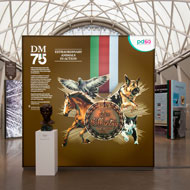
PDSA commemorates hero horses from WWI and 2
An exhibition honouring hero horses from World War One and Two has gone on display to the public for the first time.
Based at the National Army Museum in Chelsea, London, the exhibition forms part of celebrations marking the 75th anniversary of the PDSA Dickin Medal.
Emma Harper, head of exhibitions at the National Army Museum, said: “We are very excited to host part of PDSA’s debut exhibition this half term which provides a fantastic opportunity to bring to life the stories of the hero horses who played such a vital role during times of conflict around the world.
“The showcase is particularly complimentary to First World War artist, Alfred Munnings’ exhibition, which is currently on display and features the war horse, Warrior. It’s a fantastic opportunity to knit these two poignant exhibitions together and we hope people will go away with a greater understanding of the incredible role that horses and animals have played in the theatre of war.”
The PDSA medal is awarded to animals that display conspicuous gallantry or devotion to duty while serving in military conflict. It was first awarded to a messenger pigeon named Winkie on 3 December 1943.
Recipients of the medal include 34 dogs, 32 pigeons, four horses and one cat. An Honorary PDSA Dickin Medal was also bestowed to ‘the real war horse’, Warrior, on 2 September 2014, on behalf of the 16 million animals that served in the Great War.
The exhibition - PDSA Dickin Medal: Extraordinary Animals In Action - will be touring the UK over the next two years, and will be on display at the National Army Museum until 27 February 2019.
Image (C) PDSA.



 The BSAVA has opened submissions for the BSAVA Clinical Research Abstracts 2026.
The BSAVA has opened submissions for the BSAVA Clinical Research Abstracts 2026.